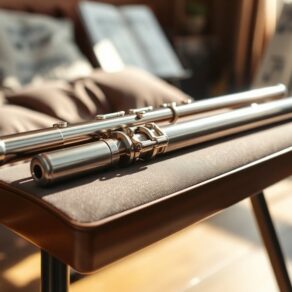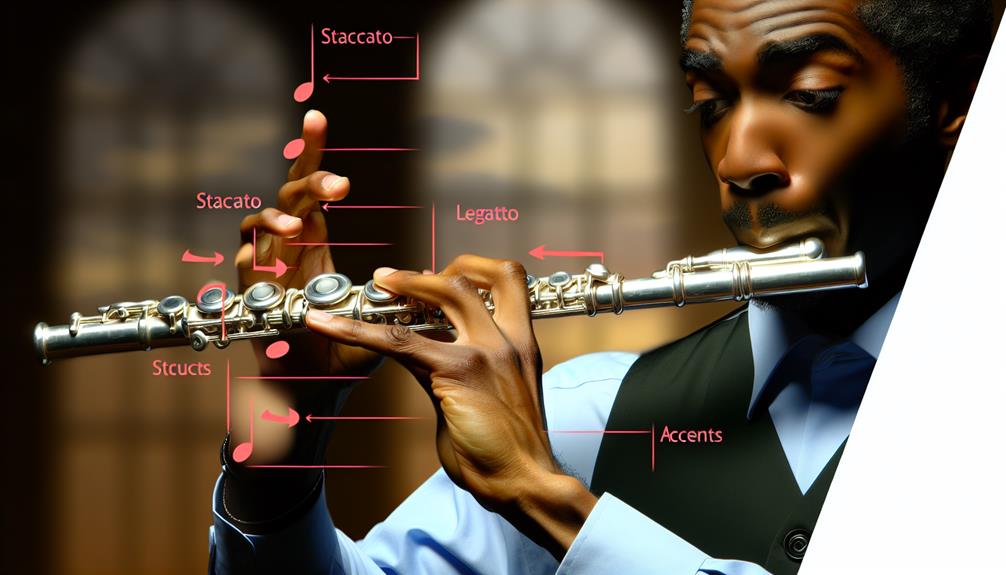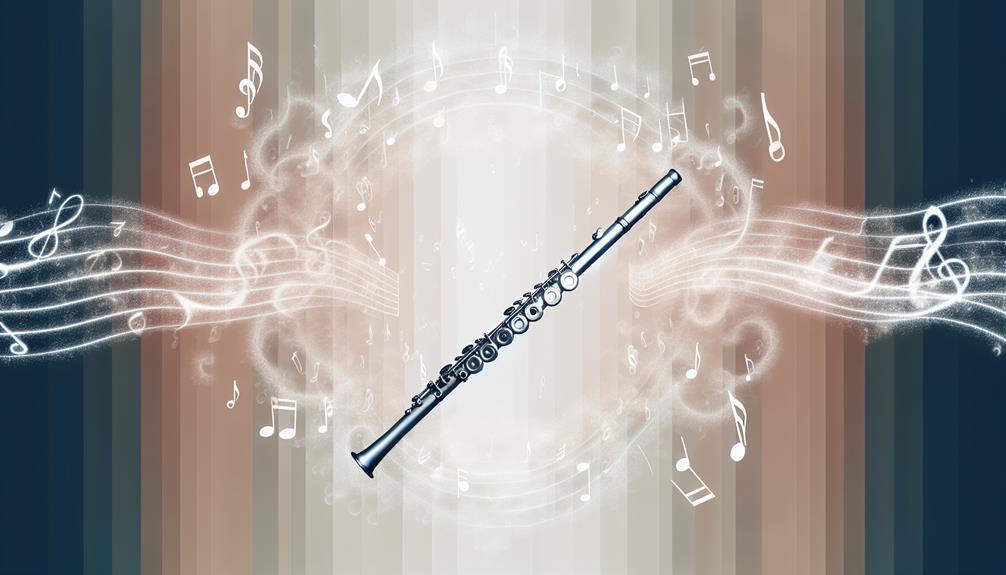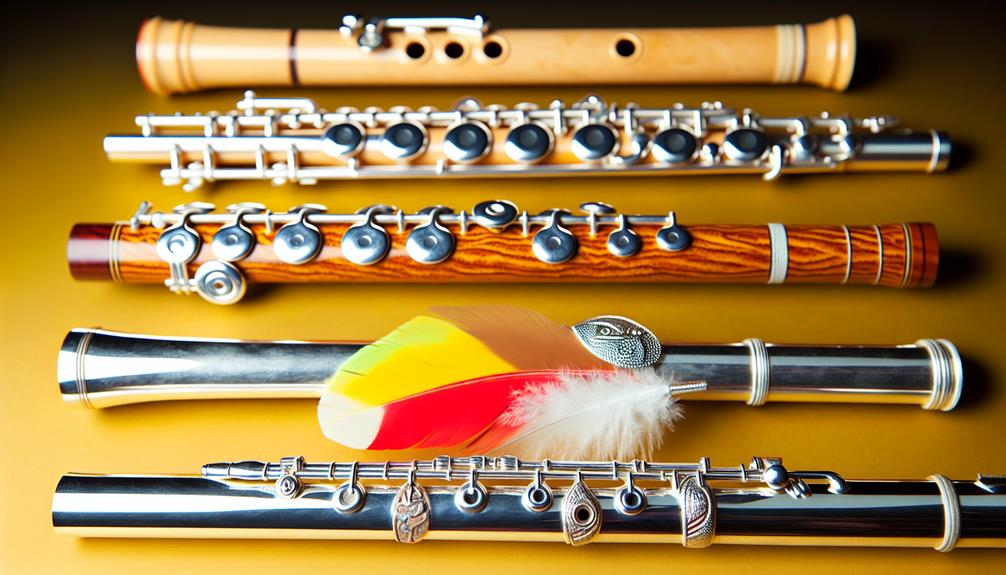Exploring the domain of advanced flute techniques opens a gateway to a world of musical artistry that transcends the conventional boundaries of the instrument. The mastery of techniques like double and triple tonguing, vibrato, circular breathing, and the intricate universe of extended techniques introduces a dimension of expressiveness and creativity that propels musicians towards new sonic horizons. As flutists investigate these sophisticated methods, they not only refine their technical skills but also unearth a treasure trove of innovative sounds and textures waiting to be discovered, reshaping the very essence of musical performance and interpretation.
Key Takeaways
- Advanced embouchure techniques for rich tone production and control.
- Mastery of breath control for dynamic expression and sustained phrases.
- Finger dexterity drills for agility and precision in complex passages.
- Articulation techniques like double and triple tonguing for clarity and speed.
- Exploring extended techniques like vibrato, circular breathing, multiphonics, and flutter-tonguing for artistic expression.
Introduction
In the domain of flute playing, mastering advanced techniques is an essential step towards achieving excellence in performance.
In this guide, we will provide an overview of the key points that will be covered to help you navigate the intricacies of these techniques effectively.
Understanding these foundational aspects will lay the groundwork for a successful exploration of the flute's diverse techniques.
Importance of mastering advanced techniques
Mastering advanced flute techniques is a pivotal step towards elevating one's musical proficiency to a higher level of artistry and expression. Technique mastery is fundamental as it enables a flutist to navigate complex musical passages with precision, agility, and control. By honing these advanced skills, performers reveal a myriad of performance benefits. These include increased accuracy in playing difficult passages, enhanced tone quality, expanded dynamic range, and greater versatility in musical interpretation.
Furthermore, mastering advanced techniques opens up new avenues for artistic expression. It allows musicians to convey emotions, tell stories, and paint vivid musical landscapes with unparalleled depth and nuance. Through advanced techniques such as multiphonics, flutter-tonguing, and circular breathing, flutists can create innovative sounds and textures that captivate audiences and push the boundaries of traditional flute playing.
In essence, the importance of mastering advanced flute techniques cannot be overstated. It is the cornerstone upon which technical proficiency, performance excellence, and artistic creativity are built, empowering flutists to reach new heights in their musical journey.
Overview of what will be covered in this guide
Having established the foundational significance of advanced flute techniques, the upcoming guide will intricately explore the all-encompassing overview of topics essential for honing a flutist's skill set.
The guide will examine advanced embouchure techniques, focusing on the nuanced adjustments required for producing a rich, resonant tone.
Exploring the intricacies of breath control mastery will be a central theme, elucidating the importance of diaphragmatic support, controlled exhalation, and the utilization of air speed to achieve dynamic expression.
Additionally, the guide will provide a detailed breakdown of finger dexterity drills, designed to enhance agility, precision, and coordination in executing complex musical passages.
Through systematic and targeted exercises, flutists will develop the muscle memory and flexibility necessary for seamless shifts between notes and challenging technical passages.
Chapter 1: Double Tonguing and Triple Tonguing
Chapter 1 of the 'Flute Techniques' article explores the intricate world of double tonguing and triple tonguing, essential articulation techniques for flutists.
These techniques involve mastering the coordination of the tongue to produce rapid and precise articulation patterns.
Flutists can enhance their skills by incorporating these techniques into their daily practice routines.
Introduction to Articulation Techniques
Double tonguing and triple tonguing are essential articulation techniques in flute playing that involve using the tongue to produce rapid and precise notes.
Double tonguing typically alternates between the syllables 'tuh-kuh' or 'duh-guh,' while triple tonguing incorporates a third syllable like 'tuh-kuh-tuh' or 'duh-guh-duh' for even faster passages.
These techniques are commonly used to articulate quick and complex passages with clarity and fluency in flute music.
Definition and purpose of double and triple tonguing
Utilizing multiple tonguing techniques, such as double and triple tonguing, is essential for achieving precise articulation and rhythmic accuracy in flute performance. Double tonguing involves alternating between syllables like 'tu-ku' for increased speed and precision. Triple tonguing adds a third syllable, such as 'tu-tku' for even faster passages. Regular practice with exercises focusing on smooth shifts between these techniques enhances overall fluency.
| Techniques | Benefits |
|---|---|
| Double Tonguing | Enhanced Speed and Precision |
| Triple Tonguing | Increased Articulation Control |
Techniques for Double Tonguing
Double tonguing is a fundamental technique in flute playing that involves using two different syllables, typically 'tu-ku,' to articulate rapid passages. Mastering this technique requires precision and control to smoothly shift between the syllables for smooth and accurate articulation.
Through dedicated exercises focused on developing speed and accuracy, flutists can enhance their double tonguing skills and elevate their playing proficiency.
Detailed explanation of the "tu-ku" syllable method
The 'tu-ku' syllable method is a fundamental technique utilized by flutists to enhance articulation and precision in their playing.
Syllable method variations allow for customization based on individual preferences and playing styles.
Flutists often face articulation challenges when incorporating this technique, requiring precise coordination between tongue and air streams.
Smooth shifts between 'tu' and 'ku' sounds are vital for maintaining a seamless and controlled musical performance.
Exercises to develop speed and precision
Building upon the foundation of articulation exercises, the development of speed and precision in flute playing can be further enhanced through targeted exercises such as Double Tonguing and Triple Tonguing.
Precision drills help refine coordination, while speed development increases agility. These exercises require focused practice to improve rhythmic accuracy and control over note articulation, ultimately enhancing overall performance quality and technical proficiency.
Techniques for Triple Tonguing
Exploring the domain of triple tonguing in flute playing requires a meticulous approach to mastering the 'tu-ku-tu' syllable technique. By understanding the mechanics behind this method, flutists can achieve seamless shifts between notes and enhance their overall performance.
Practicing specific exercises tailored to triple tonguing is essential for developing speed, precision, and control in executing this advanced technique.
Explanation of the "tu-ku-tu" syllable method
Implementing the 'tu-ku-tu' syllable method in flute playing requires mastering the intricate coordination of tongue movements and airflow modulation. This technique enhances rhythmic patterns and articulation methods, drawing on vocal techniques to improve flute articulation.
Syllable exercises play a pivotal role in advancing flute techniques, aiding in the development of precision and control in playing complex passages.
Exercises to achieve smooth transitions
To refine connections between notes and achieve seamless continuity in flute playing, mastering the techniques of double tonguing and triple tonguing is essential. Particularly focusing on the nuanced intricacies of triple tonguing for enhanced fluency and precision.
Smooth articulation can be achieved through dedicated practice routines that target the coordination between the tongue and air stream. This approach addresses performance challenges related to speed and accuracy in transformations.
Incorporating into Practice
When incorporating double and triple tonguing into flute practice, it is essential to focus on smooth shifts between the two techniques.
Combining these tonguing methods with scales and arpeggios can improve articulation and overall fluency.
Additionally, applying double and triple tonguing in various repertoire pieces can enhance musicality and technical proficiency.
Combining double and triple tonguing with scales and arpeggios
Incorporating both double and triple tonguing techniques with scales and arpeggios requires precise coordination and mastery of articulation control in flute playing.
- Articulation variations provide dynamic expression.
- Speed challenges demand agility and accuracy.
- Musical applications showcase the versatility of these techniques in various genres.
Application in repertoire
The integration of double tonguing and triple tonguing techniques into flute repertoire enhances the musician's ability to execute complex passages with precision and clarity.
Performance challenges are met with a blend of technical proficiency and artistic expression, elevating musical interpretation.
Repertoire selection plays an important role in applying these techniques effectively, requiring dedicated practice strategies to master the intricacies of each piece.
Chapter 2: Vibrato: How to Develop and Control It
Vibrato is a technique that adds depth and emotion to flute playing. Developing a consistent vibrato requires mastering control over the speed and intensity of the oscillations.
Understanding Vibrato
Vibrato is a technique in which the pitch of a note is varied rapidly, adding a subtle, expressive quality to the sound.
There are two main types of vibrato: hand vibrato, created by moving the hand or fingers, and diaphragmatic vibrato, produced by using the breath.
Understanding and mastering vibrato is vital for flute players, as it adds depth, emotion, and richness to their musical performances.
Definition and types of vibrato
When discussing the nuances of vibrato in flute playing, understanding the various types and their distinct characteristics is essential for developing and controlling this expressive technique.
- Vibrato techniques, benefits
- Vibrato in performance
- Developing vibrato control
Exploring the different types of vibrato can enhance musical expression, add depth to performances, and provide the flutist with a versatile tool for artistic interpretation.
Importance of vibrato in flute playing
As flutists explore further into mastering the nuances of flute playing, the significance of incorporating vibrato emerges as a fundamental aspect in enhancing musical expression and artistic interpretation.
Understanding vibrato techniques, such as diaphragmatic vibrato or finger vibrato, offers a range of benefits including adding warmth, depth, and emotion to the sound.
Developing control over vibrato enables flutists to convey a more nuanced and expressive musical performance.
Techniques to Develop Vibrato
In the domain of flute performance, the mastery of vibrato is an essential skill that can elevate a player's musical expression.
Understanding the nuances between diaphragmatic and throat vibrato is fundamental for developing a versatile and controlled vibrato technique.
Through targeted exercises designed to enhance control and consistency, flutists can hone their vibrato skills and imbue their playing with depth and emotion.
Diaphragmatic vs. throat vibrato
Engaging in a comparison between diaphragmatic and throat vibrato reveals distinct differences in the mechanisms employed to produce these two vibrato techniques in flute performance.
- Diaphragmatic control allows for a more subtle and controlled vibrato effect.
- Vibrato techniques impact the overall tone quality and emotional depth of the music.
- Artistic expression is enhanced through the mastery of different vibrato methods.
Exercises to develop control and consistency
To further develop control and consistency in flute performance, targeted exercises can be utilized to refine vibrato techniques and enhance musical expression.
Focus on tone control by practicing long tones with subtle variations in pitch. Improve finger dexterity with scales and arpeggios at different tempos. Work on breath support through exercises like breathing gym routines and long phrases without breaks to strengthen airflow control.
Controlling Vibrato
Controlling vibrato on the flute involves mastering the adjustment of both speed and amplitude to achieve different expressive effects.
Understanding how to use vibrato in various musical contexts is essential for conveying emotion and enhancing musical phrasing.
Developing the skill to control vibrato adds depth and richness to flute playing, allowing for a more nuanced and nuanced interpretation of musical pieces.
Adjusting speed and amplitude
Adjusting the speed and amplitude of vibrato in flute playing requires a nuanced understanding of how to manipulate these elements to enhance musical expression and control.
- Dynamics control
- Vibrato speed
- Articulation precision
- Circular shifts
- Extended range
- Breath control.
Using vibrato expressively in different musical contexts
Utilizing vibrato in flute performance adds a layer of depth and emotion, allowing for nuanced expression and interpretation across a variety of musical genres and styles. Expressive vibrato can greatly enhance the artistic interpretation of a piece, adapting to different musical contexts. The table below illustrates the impact of vibrato in conveying diverse emotions and moods in music.
| Emotion/Mood | Vibrato Technique |
|---|---|
| Serene | Slow, subtle |
| Agitated | Fast, intense |
| Romantic | Wide, pulsating |
| Mysterious | Fluttery, irregular |
Practice Tips
To enhance your flute playing, incorporating vibrato exercises into your daily practice routine is essential.
By focusing on developing control and consistency in your vibrato technique, you can effectively apply it to pieces, adding depth and emotion to your music.
Utilizing these practice tips will help you master the art of vibrato and elevate your overall flute performance.
Integrating vibrato exercises into daily practice
Incorporating vibrato exercises consistently into daily practice routines is essential for developing and refining the control and depth of this expressive technique.
- Benefits of Daily Vibrato Practice:
- Enhances vibrato control
- Establishes a structured daily routine
- Improves overall expressive playing
Consistent practice guarantees gradual improvement in vibrato quality, enhancing the emotive power of your flute performances.
Applying vibrato in pieces
After mastering vibrato control through consistent daily practice, the next step in honing this expressive technique involves seamlessly integrating it into pieces, as outlined in Chapter 2: Vibrato: How to Develop and Control It: Practice Tips.
Utilize various vibrato techniques to enhance expressive playing and elevate musical interpretation. Experiment with different speeds and depths of vibrato to add emotional depth and nuance to your performance, enriching the overall musical experience.
Chapter 3: Circular Breathing
Circular breathing is a fundamental technique for wind instrumentalists, including flutists, to maintain a continuous sound without interruption.
It involves simultaneously inhaling through the nose while pushing air out from the cheeks to sustain a seamless note.
Mastering this technique requires a combination of precise tongue control, breath support, and coordination between inhaling and exhaling.
Introduction to Circular Breathing
Circular breathing is a technique utilized by wind musicians to maintain a continuous sound without interruption.
It involves storing air in the cheeks while simultaneously breathing in through the nose to produce a seamless stream of sound.
This technique is particularly beneficial for flutists as it allows for extended phrases and uninterrupted melodies.
Definition and benefits of circular breathing
Circular breathing is a fundamental technique utilized by flutists to maintain a continuous stream of sound without interruption, allowing for extended playing durations and seamless shifts between notes.
- Benefits:
- Enhances endurance and control
- Enables sustained melodies
- Facilitates intricate musical passages
Circular breathing requires mastering specific breathing exercises and techniques to overcome initial challenges. Its application enhances performance quality, making it a valuable skill for flutists.
Techniques to Master Circular Breathing
To master circular breathing on the flute, it is essential to follow a step-by-step guide that breaks down the technique into manageable components.
Additionally, incorporating specific exercises into your practice routine can help refine the coordination required for seamless circular breathing.
Step-by-step guide to learning circular breathing
Mastering the art of circular breathing, an essential technique for playing the flute proficiently, requires dedicated practice and focused attention on the coordination of breathing and playing.
- Circular Breathing Benefits, Challenges
- Circular Breathing Practice Routines
- Circular Breathing Performance Applications
These elements form the foundation for developing proficiency in circular breathing, revealing a world of extended musical possibilities for flutists.
Exercises to practice the technique
Practicing the technique of circular breathing through structured exercises is essential for enhancing respiratory control and achieving seamless airflow continuity while playing the flute.
To master circular breathing, focus on exercises that improve tone production by maintaining consistent airflow, enhance finger dexterity for uninterrupted playing, and strengthen breath control for sustained notes.
Integrate these exercises into daily practice sessions to gradually build proficiency in this advanced flute technique.
Applications in Performance
Mastering circular breathing opens up a world of possibilities in flute performance. Particularly when tackling extended passages that require seamless changes. Understanding techniques to maintain a consistent airflow while simultaneously taking in new breaths is essential for achieving a continuous and uninterrupted sound.
Using circular breathing in extended passages
Implementing circular breathing technique in extended passages necessitates a seamless integration of controlled inhalation and exhalation, ensuring a continuous flow of sound without interruption.
- Breath Control: Mastering breath control is vital for sustaining notes seamlessly.
- Practice Methods: Regular practice sessions focusing on circular breathing are essential for proficiency.
- Performance Applications: Utilizing circular breathing enhances musical expression and allows for extended passages without breaks.
Tips for seamless transitions
In the domain of flute performance, achieving seamless shifts while employing the circular breathing technique is a hallmark of advanced skill and artistry. Smooth progressions are essential for maintaining musicality.
Mastering breath control is pivotal for articulation during progressions. Developing a seamless technique guarantees performance excellence.
Attention to detail and consistent practice are key in perfecting these progressions, enhancing the overall quality of musical expression.
Chapter 4: Extended Techniques (Multiphonics, Flutter-Tonguing, etc.)
Chapter 4 explores the world of extended techniques in flute playing. It introduces multiphonics, flutter-tonguing, and other advanced methods. These techniques offer a unique way for flutists to investigate the full potential of their instrument, creating innovative sounds and textures.
Understanding and mastering these extended techniques can greatly expand a flutist's repertoire and artistic expression.
Introduction to Extended Techniques
Extended techniques in flute playing refer to unconventional methods that expand the instrument's sonic possibilities beyond traditional playing techniques.
Multiphonics, for instance, involve producing more than one pitch simultaneously by manipulating the embouchure and airflow.
Flutter-tonguing, on the other hand, creates a rapid fluttering sound by rolling the tongue while playing.
Definition and examples of extended techniques
Exploring the world of advanced flute performance techniques reveals a rich tapestry of innovative methods that push the boundaries of traditional playing styles.
- Extended Techniques: These techniques involve unconventional ways of playing the flute.
- Creative Exploration: Artists experiment with new sounds and approaches.
- Experimental Sounds: Pushing the limits of traditional flute music with unique and avant-garde sounds.
Multiphonics
Multiphonics in flute playing refers to the technique of producing more than one pitch simultaneously. This effect is achieved by manipulating the airflow and embouchure while playing.
Understanding the mechanics behind multiphonics and practicing specific exercises can help flutists control and integrate this technique into their repertoire effectively.
Explanation and method to produce multiphonics
An advanced technique utilized by flutists to produce multiple tones simultaneously involves intricate manipulation of embouchure and airflow control.
- Harmonic overtones, experimental sounds
- Tone color, unconventional techniques
- Sound effects, contemporary music
Flutists explore multiphonics to create unique textures and enrich their musical expression, often delving into unconventional methods to produce experimental sounds that add depth and complexity to their performances.
Exercises to practice and control multiphonics
To hone the skill of producing and controlling multiphonics on the flute, flutists can engage in a series of structured exercises designed to refine embouchure precision and airflow modulation. These exercises focus on multiphonics mastery, emphasizing control and precision in sound production.
Through consistent practice, flutists can develop the necessary techniques to manipulate airflow and embouchure for achieving a wide range of multiphonic sounds with accuracy.
Flutter-Tonguing
Flutter-tonguing is a technique where the flutist rolls their tongue while playing to create a distinctive fluttering sound. To achieve this effect, precise control of air speed and tongue movement is required.
Developing consistency in flutter-tonguing involves practicing various exercises that focus on coordination and agility between the tongue and the airstream.
Techniques to produce flutter-tonguing
Utilizing a nuanced embouchure adjustment, skilled flutists can effortlessly shift into the intricate technique of flutter-tonguing, adding a dynamic layer to their musical expression.
- Flutter tonguing variations
- Breath control
- Articulation exercises
Mastering these elements is essential for achieving a clear and controlled flutter-tonguing technique. Consistent practice and attention to detail are necessary for developing proficiency in this advanced flute skill.
Exercises to develop consistency
Developing consistency in flutter-tonguing requires a disciplined approach to targeted exercises that focus on refining embouchure control, breath management, and articulation precision.
To enhance tone quality, practice sustained notes while flutter-tonguing. Work on breath control by incorporating dynamic variations into your exercises. Improve finger dexterity by integrating scales and arpeggios into your routine.
Consistent practice of these exercises will lead to proficiency in flutter-tonguing.
Other Extended Techniques
Discovering the domain of extended flute techniques reveals a myriad of sonic possibilities beyond the traditional. Key slaps, whistle tones, and other unconventional methods open avenues for creative expression and unique timbres.
These techniques find practical application in contemporary musical compositions, offering flutists a diverse toolkit to enhance their performances.
Key slaps, whistle tones, and more
In the domain of advanced flute techniques, the exploration of key slaps, whistle tones, and various other extended techniques opens up a world of sonic possibilities for the discerning flutist.
- Key slaps add percussive elements
- Whistle tones create ethereal sounds
- Extended techniques, like harmonics, enrich modern compositions
These techniques require precise embouchure control, breath modulation, and mastery of articulation for nuanced tone production.
Practical applications in modern repertoire
The integration of key slaps, whistle tones, and other extended techniques into modern repertoire presents flutists with a rich tapestry of sonic textures and expressive possibilities.
Modern interpretations of these techniques challenge flutists to push boundaries and experiment with new sounds.
Incorporating progressive techniques like key slaps and whistle tones into contemporary pieces adds depth and complexity, requiring a high level of skill and creativity from the performer.
Conclusion
To sum up, a thorough grasp of extended flute techniques, such as multiphonics and flutter-tonguing, is crucial for aspiring flutists. Mastery of these advanced techniques not only enhances musical expression but also expands artistic possibilities.
Looking ahead, ongoing exploration and practice are necessary for the continual development and refinement of one's flute playing skills.
Summary of key points
Examination of the fundamental techniques in flute playing reveals a nuanced interplay of breath control, finger dexterity, and embouchure precision. Mastery of these core elements forms the foundation upon which advanced flute techniques are built.
Delving deeper into the world of advanced flute playing uncovers a tapestry of intricacies that require a blend of discipline, creativity, and dedication. To summarize the key points discussed up to now:
- Performance Challenges, Practice Strategies: Overcoming the technical hurdles and honing one's skills through targeted practice routines is essential for maneuvering the demanding repertoire of advanced flute music.
- Artistic Expression, Technical Mastery: Balancing technical prowess with artistic interpretation is the hallmark of a skilled flutist capable of delivering enthralling performances that resonate with audiences.
- Musical Innovation, Creative Exploration: Embracing a spirit of experimentation and pushing the boundaries of traditional flute playing opens the door to new musical possibilities and fosters a culture of innovation within the flute community.
ncouragement to explore and master advanced techniques
Having explored the intricacies of fundamental techniques, the journey towards mastering advanced flute techniques beckons with a blend of curiosity and determination. The path to mastery is not without its challenges, as delving into advanced techniques requires dedication and perseverance. Exploration challenges may arise in the form of complex fingering patterns, extended techniques such as multiphonics or flutter-tonguing, and intricate rhythmic structures. However, overcoming these obstacles leads to a profound sense of accomplishment and growth as a musician.
Furthermore, Mastery rewards await those who persist in their pursuit of advanced flute techniques. The ability to execute these techniques with precision and expressiveness opens up a world of musical possibilities, allowing for deeper emotional communication through the instrument. Additionally, mastering advanced techniques enables flute players to push the boundaries of traditional flute repertoire and explore new avenues of musical expression through technique innovation. By continuously challenging themselves and embracing the journey of mastering advanced techniques, flutists can reach new heights of artistry and creativity in their musical endeavors.
Next steps for further development
After exploring through the challenges and rewards of mastering advanced flute techniques, the journey towards further development beckons with an array of new opportunities for growth and refinement.
- Tone development, breath control:
Continue refining your tone quality by working on exercises that focus on dynamics, articulation, and intonation. Implementing breathing exercises and techniques such as long tones can enhance breath control, allowing for sustained phrases and improved overall sound production.
- Musical interpretation, performance skills:
Explore different musical styles and genres to expand your interpretive abilities. Investigate the nuances of phrasing, expression, and musical storytelling. Practice performing in front of others to develop confidence, stage presence, and connection with your audience.
- Practice routines, self-assessment:
Establish a structured practice routine that includes scales, etudes, and repertoire. Set specific goals and track your progress regularly. Utilize recordings or seek feedback from teachers and peers to critically assess your playing and identify areas for improvement. Embrace a growth mindset, continuously aiming for excellence in your flute playing journey.
Frequently Asked Questions
How Can I Prevent My Flute From Getting Tarnished Over Time?
To prevent your flute from tarnishing over time, proper cleaning and maintenance are essential.
Regularly clean your flute with a soft cloth after each use to remove moisture and fingerprints that can contribute to tarnishing.
Store your flute in a protective case when not in use to prevent exposure to air and moisture.
Consider using anti-tarnish strips or cloths in your case to further protect your flute from tarnish.
Are There Specific Exercises to Improve Finger Dexterity for Flute Playing?
Improving finger technique for flute playing involves dedicated practice routines focusing on flute-hand coordination exercises.
Incorporating speed and accuracy drills specifically designed for flute fingers can enhance dexterity.
Utilizing scales, arpeggios, and trills can help build strength and agility in the fingers.
Consistent and structured practice sessions targeting these areas can lead to significant improvements in finger dexterity, ultimately enhancing overall flute performance.
What Is the Best Way to Care for and Maintain a Wooden Flute?
To properly care for and maintain a wooden flute, it is essential to follow specific guidelines.
Oiling techniques should be employed regularly to prevent the wood from drying out and cracking.
Cleaning methods involving gentle swabs and cloths should be used to remove moisture and dirt.
Proper storage tips, such as keeping the flute in a case with humidity control, are vital in maintaining its integrity.
Polishing instructions should be followed, and crack prevention measures should be taken to guarantee the longevity of the instrument.
Can You Recommend Effective Methods for Improving Breath Control?
Improving breath control is essential for musicians.
To enhance this skill, engaging in breathing exercises and techniques can be beneficial.
These exercises focus on increasing lung capacity, strengthening diaphragm control, and promoting overall respiratory health.
Are There Any Recommended Flute Maintenance Tools or Kits Available?
When it comes to flute maintenance, having the right tools is essential. Flute cleaning requires precision and care, making specialized repair tools important. Investing in a quality maintenance kit can simplify the process and guarantee your instrument remains in excellent condition.
Look for kits that include cleaning rods, key oil, polishing cloths, and pad paper. Proper maintenance tools will not only prolong the life of your flute but also enhance its performance.
Conclusion
To sum up, mastering advanced flute techniques demands dedication, practice, and an unwavering commitment to musical excellence. By exploring double and triple tonguing, developing vibrato, mastering circular breathing, and delving into extended techniques like multiphonics and flutter-tonguing, flutists can expand their musical horizons and reveal a world of expressive possibilities.
The question remains: How far can one push the boundaries of traditional flute playing to reach new levels of artistry and creativity?






